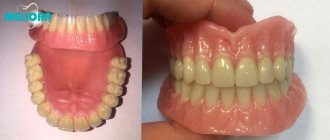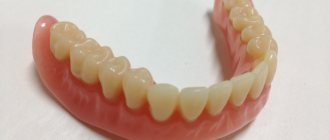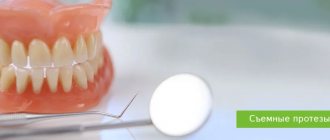Chief editor of the site:
Snitkovsky Arkady Alexandrovich
Chief physician of the professorial dentistry “22 Century”, dentist, orthopedic dentist
Author of the article:
Scientific team of dentistry “22 Century”
Dentists, candidates and doctors of medical sciences, professors
Plate prosthesis
A plate prosthesis is the most common of the simple and affordable methods of removable prosthetics for complete or partial absence of teeth. Let's look at the materials and stages of its manufacture.
Plate prosthesis - what is it and what does it look like?
This is a removable prosthetic structure consisting of a base (made of polymer compounds) and artificial crowns. Some models are equipped with locking elements. As a rule, such prostheses are made of acrylic, polyurethane composition or a nylon base. The final price of the structure depends on the choice of prosthesis material.
Plate dentures are installed in the following cases:
- when a person is missing several teeth or is completely edentulous;
- if it is not possible to perform classical implantation with subsequent prosthetics (for example, with certain contraindications or with limited funds);
- when the patient is allergic to metal alloys;
- when it is impossible to install classic “bridges” or clasp dentures;
- if you need to wear a temporary prosthesis while a permanent one is being made, or dental implants are taking root.
It is important!
A good removable denture structure made from high-quality materials is manufactured strictly in accordance with the individual parameters of the patient’s upper and lower jaw. Standard (ready-made) dentures will never work!
The presented removable dentures are not recommended for installation if the patient has gum disease in the acute stage, suffers from diseases of the circulatory system, or has mental disorders. Also, these prostheses are not recommended for use during chemotherapy in patients with cancer. Prosthetics should be postponed to the future if, at the time of installation of new teeth, a person is diagnosed with inflammatory processes in the body.
The average duration of use of a removable prosthetic structure is from three to five years, but with careful use and provided that a modern prosthesis is installed on implants, it can last ten years.
Experts recommend changing the prosthesis on time, since over time, due to pressure, deformation of the gums occurs, the prosthesis “sags,” the clasps become loose, the material wears out and cannot cope with the distribution of the chewing load, and most importantly, the design no longer copes with its tasks, bone atrophy occurs fabrics.
Adjustment period
The period of adaptation to a removable lamellar prosthesis takes about 3–4 weeks. At this time, the prosthesis will feel like a foreign body. There may be difficulties with speaking and chewing food. If the structure on the upper jaw also occupies the palate, the taste of food may not be felt. In some cases, increased salivation and nausea are observed. Usually such unpleasant moments pass quickly. For speedy adaptation, dentists recommend not removing the denture in the first days, even at night, and wearing it constantly. If the feeling of pain and discomfort does not disappear, or, on the contrary, intensifies, it is recommended to consult a specialist.
The nuances of using plate dentures
- Relative fragility. There is a high risk of deformation under significant loads on the artificial system. If the plastic structure is used carefully and not loaded with solid food, it will last for the entire period of use.
- There are problems with getting used to it and discomfort when wearing it. This is due to pressure on the gums, as well as the large size of the base. At first, there may be problems with diction (especially with pronouncing hissing and whistling sounds). However, modern dental technologies do not stand still - the most comfortable systems are manufactured, which you get used to very quickly, and which do not injure your gums.
- There is no load on the bone. However, if you install a removable prosthetic structure supported by metal implants, the load will be distributed on the bone tissue.
Design features
A removable lamellar prosthesis consists of a base, retaining devices, and artificial organs. It effectively reduces the mobility of the base teeth, evenly distributes the load on the tissues of the prosthetic bed, and has maximum working efficiency. The emergence of innovative materials, improvement of milling techniques and the use of high-precision casting have significantly expanded the possibilities of manufacturing plate-based devices. Thanks to this method, modern acrylic structures are aesthetically pleasing, do not require a lot of getting used to, and do not cause discomfort. After examining the patient’s oral cavity and performing preventive/therapeutic procedures, an impression is taken to create a model of the product. Dental laboratory specialists make the prosthesis, polish and grind it. The orthopedic dentist installs the finished restoration in the oral cavity, correcting it if necessary.
Types of plate prostheses - key types, capabilities, features, advantages of each of them
1. Complete – a denture that is a worthy replacement for the upper and lower jaws. The main feature of the prosthetic design is the large base, which allows the system to be securely secured in the mouth.
Fixation options:
- on locks - allow you to secure a removable denture if there are at least two healthy teeth in the jaw;
- on suction cups – fixation is achieved by creating a vacuum between the prosthesis and the oral mucosa;
Note!
To more reliably attach the structure to the mucous membrane, special gels and creams are used. This is especially true for the bottom row.
- on screwed-in implants instead of chewing teeth - one of the best fixation options, when the prosthesis “clings” to several embedded titanium roots. But this option for attaching a prosthesis has one drawback - the price of implants installed can be several times higher than the cost of the prosthesis itself.
2. A partial is a plate prosthesis that allows you to replace one or several teeth in a row. The main advantage of such a partial denture is that you do not need to prepare healthy teeth to fix it. Modern clasp systems guarantee strong fixation.
Fixation options:
- on metal-free clasps - an improved version of classic metal clasps, the elements are made of soft materials;
- on metal clasps there are hooks that are built into the base of the partial system and “cling” to the cervical area of a healthy tooth. Today they are used extremely rarely, since there is a high risk of damaging the surface of a living tooth;
- Attachments are locking fixing systems that are placed on both a removable partial denture and a healthy tooth. When fixing, a characteristic click is heard, indicating that the partial system is securely fastened.
Why is prosthetics necessary?
Violation of the integrity of the dental system can be caused by the loss of even one tooth. If there are more lost units, the health consequences are enormous:
- Deformation of the chewing surface of the rows occurs.
- The bite suffers, changes affect the anatomy of the temporomandibular joint.
- The smile loses its attractiveness.
- Poor chewing of food leads to gastrointestinal problems.
Timely prosthetics will help reduce undesirable consequences. One of the options for restoring teeth is a plate prosthesis, which is recommended for installation in the absence of all teeth or the loss of some elements of a row.
How a plate prosthesis is created - the process in stages
Stage No. 1 – consultation with a dentist and prosthetist, planning of prosthetics. The patient is also sent to take panoramic photographs of the jaw; the type of structure (full or partial) and the material from which the prosthesis will be made are specified.
Stage No. 2 - the dentist takes impressions of the jaw, evaluates the bite, and sends the data to the technical laboratory, where the prosthetic structure will be created.
Stage No. 3 – fitting and correction of the position of the test structure of the prosthesis made of wax.
Stage No. 4 is the process of “adjusting” the finished prosthesis to the individual parameters of the jaw.
Stage No. 5 – “fitting” the finished removable plastic prosthesis, checking the strength of fixation.
Note!
When compared with other options for creating structures, the plate one is made relatively simply and quickly. The patient can count on quickly receiving a prosthesis, which is important when installing a temporary solution (during the healing of implants).
How much does a plate prosthesis cost?
The average price of a partial plate denture made of plastic with crowns is 10 thousand rubles. The most expensive options for complete systems will cost about 49 thousand, respectively. It is possible to choose a solution in the mid-price category - up to thirty thousand rubles. If a partial or complete removable denture with crowns is placed on artificial implants, the amount of prosthetics can be increased by approximately fifty thousand rubles.
The cost of a removable prosthetic structure includes:
- diagnostics of teeth and gums;
- making casts;
- production of the denture itself;
- fitting and adjustment of the system to the individual parameters of the patient;
- correction and possible relining of the prosthesis.
The price of a plate denture depends on the type, material, type of fastening, the number of missing teeth, the need for implants and the general condition of the patient’s oral cavity.
Kinds
Various design options are used for treatment. They are made from acrylic, nylon and other materials, differing in the method of fixation and properties.
| Characteristics/Type of construction | Acrylic based | Flexible nylon | Clasp dentures | Immediate dentures | Sandwich dentures |
| Wearing comfort | Low | High | High, no violations of taste, diction | Good, quick adaptation period | High, no violations of diction, sense of taste |
| Possibility of allergic reactions | There is a risk | Hypoallergenic material | Possible reactions to the metal frame | Depends on the crown material used | Low chance of allergies |
| Turning, preparation of support units | Optional, depends on the type of product | No | When choosing a fastening using attachments, the outer layer of enamel is removed | No | No |
| Operational terms | Three to four years | Five years | 10 years or more | Up to three to five months (used as a temporary structure) | Seven to ten years and above |
| Maintainability | Available | No | In most cases it can be repaired | Depends on material | Available |
| Strength | Low, the material is fragile | Tall, but nylon shrinks and can change geometric dimensions | High | Low | High |
| Cost, rub. | 18 000 | 8600-10000 | 25000-40000 | 7500-9300 | 40000 |
The indicated cost is approximate; it may vary depending on the condition of the tissues and oral cavity, the number of units replaced and other factors.
Expert opinion
Despite all the positive possibilities and nuances of using prosthetic structures, this is the optimal solution for replacing missing teeth on a limited budget. With such a prosthesis, it is possible to smile, chew food, and talk freely.
The 32 Dent clinic specializes in installing removable dentures for patients, including plate dentures made of plastic, nylon, and ceramic crowns. Sign up for a free consultation with a dentist or prosthetist who will expertly perform jaw prosthetic work.
If you have a problem similar to that described in this article, be sure to contact our specialists. Don't diagnose yourself!
Why you should call us now:
- We will answer all your questions in 3 minutes
- Free consultation
- The average work experience of doctors is 12 years
- Convenient location of clinics
Single contact phone number: +7
Make an appointment
Sources:
- Personal experience as an orthopedic dentist;
- Abdurakhmanov, A. I. Materials and technologies in orthopedic dentistry. Textbook / A.I. Abdurakhmanov, O.R. Kurbanov. - M.: Medicine, 2002;
- Mirgazizova, M.Z. Orthopedic dentistry / Edited by V.N. Kopeikina, M.Z. Mirgazizova. - M.: Medicine, 2001;
- Trezubov, V.N. Orthopedic dentistry. Applied materials science / V.N. Trezubov, M.Z. Shteyngart. - M.: St. Petersburg: SpetsLit; 3rd edition, 2003;
- Lebedenko I.Yu., Kalamkarova S.Kh. Orthopedic dentistry: diagnostic and treatment algorithms. - M.: Medical Information Agency, 2008;
- Ronauk, SinghTapan Singh and Jatinder Pal Singh Maxillofacial Materials – Then And Now / Ronauk Singh, Tapan Singh and Jatinder Pal Singh. - M.: LAP Lambert Academic Publishing, 2014;
- Arnold Hohmann - Principles of Design and Fabrication in Prosthodontics (2016);
- Guide to prosthetic dentistry. Prosthetics in the absence of teeth / ed. I.Yu. Lebedenko, E.S. Kalivradzhiyan, T.I. Ibragimova, E.A. Bra-gina. - M.: Medical Press LLC, 2008;
- Trezubov V.N., Mishnev L.M., Neznanova N.Yu. [and etc.]. Orthopedic dentistry. Technology of therapeutic and preventive devices. - St. Petersburg: SpetsLit, 2002.











